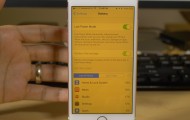Articles
Android ‘Fast Pair’ will quickly connect Bluetooth devices | Engadget
Announcing Fast Pair – effortless Bluetooth pairing for Android | Android Developers Blog
My Comments
Google has answered the setup method that Apple has implemented for their AirPod wireless in-ear headset by implementing a software-driven “quick-pair” setup that will be part of Android.
This method, called Bluetooth Fast Pairing, works on Android handsets and other devices that run Android 6.0 Marshmallow onwards and have Google Play Services 11.7 or newer installed and support Bluetooth 4.0 Low Energy (Bluetooth Smart) connectivity. You will have to enable Bluetooth and Location functionality in your handset, but you don’t have to look at Bluetooth device lists on your smartphone for a particular device identifier to complete the setup process.
It is meant to provide quick discovery of your compliant Bluetooth accessory device in order to expedite the setup process that is involved with new devices or to “repair” Bluetooth connections that have failed. This latter situation can easily occur if data in the device regarding associated Bluetooth devices becomes corrupted or their is excessive Bluetooth interference.
The user experience will require you to put your accessory device like a Bluetooth headset, speakers or car stereo in to Bluetooth-setup mode. This may simply be through you holding down the “setup” or “pair” button till a LED flashes a certain way or you hear a distinct tone. On the other hand in the case of home and car audio equipment that has a display of some form, you using the “Setup Menu” to select “Bluetooth Setup” or something similar.
Then you receive a notification message on your Android device which refers to the device you just enabled for pairing, showing its product name and a thumbnail image of the device. Tap on this notification to continue the setup process and you may receive an invitation to download a companion app for those devices that work on the “app-cessory” model for extended functionality.
Google implements this by using Bluetooth Low Energy “beacon” technology to enable the device-discovery process. This is similar to the various beacon approaches for marketing and indoor navigation that are being facilitated by Bluetooth Low Energy, but they only appear while your accessory device is in “Bluetooth setup” mode.
The Google Play servers provide information about the device such as its thumbnail image, product name or link to a companion app based on a “primary-key” identifier that is part of the Bluetooth Low Energy “beacon” presented by the device. Then, once you tap the notification popup on your Android device, the pairing and establishment process takes place under Bluetooth Classic technology.
I see this also as being similar to the various “Plug And Play” discovery process implemented in Microsoft Windows and Apple MacOS whenever you connect newer peripherals to your computer. This is where Microsoft and Apple keep data about various peripherals and expansion cards that are or have been on the market to facilitate installation of any necessary drivers or other software or invocation of class drivers that are part of the operating system. For Google and the Android platform, they could take this further with USB-C and USB Micro-AB OTG connectivity to implement the same kind of “plug and play” setup for peripherals connected this way to Android devices.
This system could be taken further by integrating similar logic and server-hosted databases in to other operating systems for regular and mobile computer platforms to improve and expedite the setup process for Bluetooth devices where the host device supports Bluetooth Low Energy operation. Here, I would like to see it based on the same identifiers broadcast by each of the accessory devices.
The Bluetooth Fast Pairing ability that Google gave to the Android platform complements NFC-based “touch and go” pairing that has been used with that platform as another method to simplify the setup process. This is more for manufacturers who don’t have enough room in their accessory device’s design to provide an NFC area for “touch-and-go” setup thanks to very small devices or where NFC doesn’t play well with the device’s aesthetics or functionality.
It may be a point of confusion for device designers like Alpine with their car stereos who place their devices in “discoverable” or “pairing” mode all the time so you can commence enrolling your accessory device at your phone’s user interface. Here, the device manufacturer may have to limit its availability to certain circumstances like no devices paired or connected, or you having to select the “Bluetooth” source or “Setup” mode to invoke discoverability.
At least Google have put up a way to allow quicker setup for Bluetooth accessories with their Android platform devices without the need to build the requirement in to the hardware.





